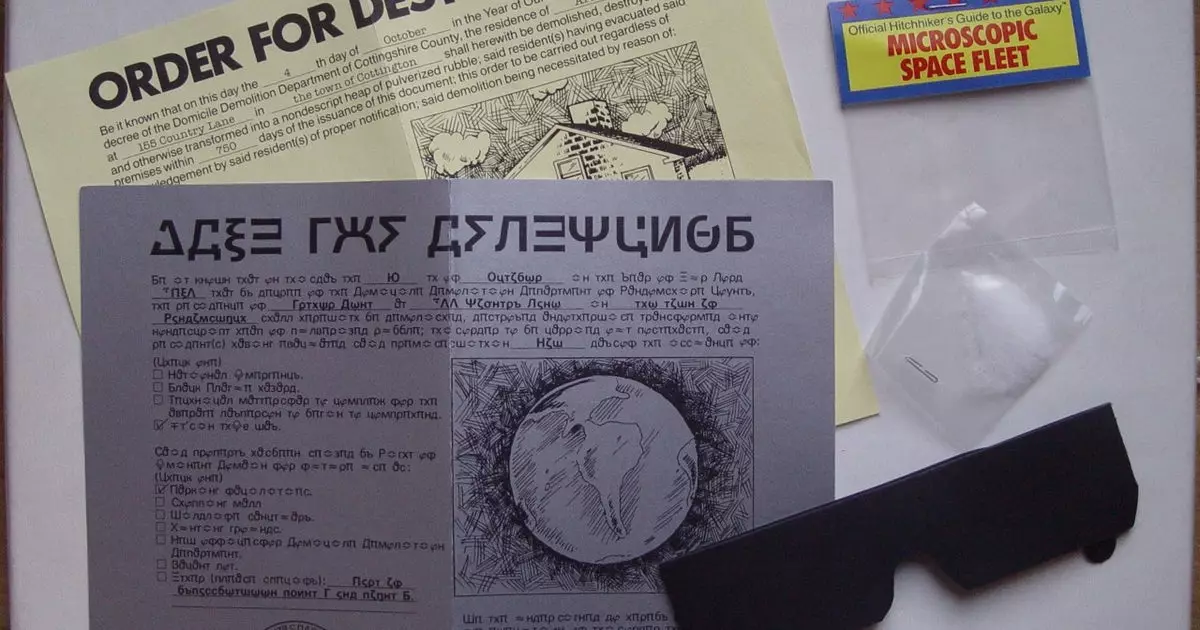In an era characterized by hyper-realistic graphics and intricate storylines, the charm of vintage gaming artifacts, known affectionately as “feelies,” stands out. One of the most notable moments in gaming archaeology comes from the 1984 release of *The Hitchhiker’s Guide to the Galaxy* adventure game by Infocom. This title didn’t just deliver a remarkable text-based gaming experience; it introduced a new paradigm by including physical items—bringing the virtual world into the tangible realm. These small, often whimsical artifacts provided a multi-sensory layer to the gameplay, enticing players to engage on a deeper level with both the game and its absurd universe.
Infocom is often credited with coining the term “feelies,” which reflects the intrinsic value of these physical items, despite their sometimes useless nature. A packet proclaiming to contain something invisible or imperceptible may seem trivial today, but it encapsulates a treasure trove of creativity and imagination that enhances the gaming experience. The notion of having an object that connects you to a narrative helper, no matter how nonsensical it may be, stirs the imagination, an aspect that’s frequently overlooked in contemporary gaming.
Character Connections: A New Perspective
The richness of involvement in gaming narratives is enriched when we explore well-developed characters. The analysis provided by Victoria Regan in her edition of ‘gaming made me’ on *The Hitchhiker’s Guide* is particularly illuminating. She paints a compelling picture of Arthur Dent, a character who often seems hapless and bewildered amidst the chaos of an indifferent universe. Regan’s perspective forces us to reconsider Arthur’s apparent lack of agency and instead view his reluctance to merely succumb to the absurdity around him as a form of understated heroism.
This fresh characterization adds depth to a protagonist who might otherwise be dismissed as a merely comedic trope. Regan highlights the courage it takes to maintain one’s identity in the face of ridiculousness. By portraying Arthur’s struggles against a backdrop of unpredictability as a clash between his sense of self and the challenges he faces, she elevates the narrative from mere whimsy to a profound exploration of resilience. Such character insights are vital. They remind us that relatable narratives often lie beneath the surface, waiting for players to uncover them.
The Quest for Discovery
There’s an inherent joy in the exploration of gaming worlds—a thrill that is significantly blunted in the modern gaming landscape dominated by spoilers and pre-release hype. Regan and her brother’s determination to unravel the mysteries embedded within the daunting puzzles of *The Hitchhiker’s Guide* is a testament to this notion. The thrill of gradual discovery—the secret joys of exploration and revelation—has largely faded as games become pre-packaged experiences laden with expectations.
In today’s gaming climate, experiences often feel curated and algorithmically crafted to fit neatly into our preconceived notions. The charm of unveiling surprises is eroded by the torrent of information bombarding players. One can’t help but reflect on how the original feelies served as gateways into an imaginative realm, offering moments of genuine curiosity and excitement that seem increasingly rare in contemporary titles. The perfectly imperfect nature of old-school gaming encourages a sense of personal ownership in the narrative, unlike today’s regimented experiences.
A New Order of Collectibles
When we consider the evolution of gaming collectibles, we see a stark contrast between the nostalgia-infused feelies of retro games and the mass-produced collectibles of today. The vast marketplace now swells with high-end statues and collectibles that often feel transactional rather than passionate. While they may appear sleek and desirable, one can’t shake off the feeling that these items are devoid of the warmth and whimsy that once characterized gaming treasures.
Old Infocom feelies are unpretentious and evoke a sense of humor about their existence—objects that acknowledge their absurdity without demanding significance. In contrast, modern collectibles often feel like vehicles for brand loyalty or conformity to commercial trends. The charm of an unassuming packet of paper or a silly object, which embraces its uselessness, is a counterbalance to the projections of value that the gaming industry now employs to create a collectible culture focused on monetary worth rather than personal connection.
More than ever, there’s a call to celebrate the quirky and the useless—artifacts that resonate with the core of what makes gaming delightful and memorable. It’s high time we cherish the charmingly absurd and seek out experiences that inspire both laughter and imagination in our interactions with games. Let us advocate for a return to that which dares to defy convention, for it is in these unique treasures that the soul of gaming truly lies.


Leave a Reply